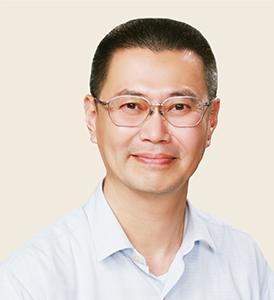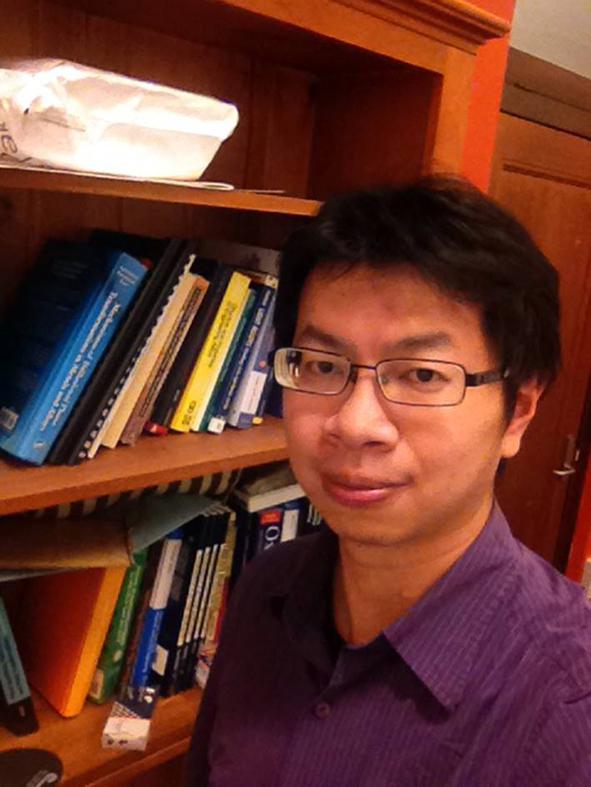110年年會特邀演講來賓
學會於110年12月11日(星期六) 於國立臺灣大學 工學院綜合大樓 國際演講廳203室 舉行第四十一屆年會暨會員大會,特別介紹年會特邀演講來賓。
章為皓 副研究員/合聘副教授 Prof. Wei-hau Chang

- 演講題目:
Untold cryo-EM stories behind the 2021 Nobel Prize of Physiology or Medicine
2021 諾貝爾生理醫學獎的幕後功臣 ----冷凍電子顯微鏡的故事
- 現 職:
中央研究院 化學所 副研究員
中央研究院 物理所 合聘副研究員
中央研究院 基因體中心 合聘副研究員
國立台灣大學 化工系 合聘副教授
- Abstract:
The Nobel Prize in Physiology or Medicine 2021 was awarded jointly to David Julius of UCSF and Ardem Patapoutian of Scripps Research Institute for their discoveries of receptors for temperature and touch. Our ability to sense heat, cold and touch is essential for survival and underpins our interaction with the physical world around us. In our daily lives we utilize these senses, but may not notice how temperature and pressure would initiate nerve impulses to generate the senses. This question at molecular level has been solved by this year’s Nobel Prize laureates in Physiology or Medicine. In brief, Julius identified the heat sensor called TRPV ion channel as the receptor of capsaicin, a pungent compound from chili peppers that induces a burning sensation, in the nerve endings of the skin that responds to heat back in 1997, and Patapoutian exploited pressure-sensitive cells to discover a novel class of sensors called Piezo proteins that respond to mechanical stimuli in the skin and internal organs back in 2010. The discoveries of the key molecules and their function characterization are considered to be incomplete for the molecular understanding of how our nervous system senses heat, cold, and mechanical stimuli until direct visualization of the molecules are achieved. However, the TRPV and Piezo are channels are membrane proteins that getting 3D pictures of them are next to impossible due to the challenges in crystallization. Fortunately, those bottlenecks were suddenly removed in 2013 when the resolution revolution of cryo-electron microscopy (cryo-EM). Since cryo-EM did not need crystals, rapid structure determinations of TRPV and Piezo were made by the cryo-EM microscopists, friends or competitors of these two laureates, in five years (2014-2019) to complete the structure part of the investigation. In this lecture, I will first brief the TRPV and Piezo protein structures. Then I will explain the keys to cryo-EM resolution revolution including imaging processing of large amount of data, followed by coverage on several research projects such as a membrane protein that converts methane to methanol and COVID-19 proteins done at Academia Sinica by using an automated cryo-EM (Titan Krios) to demonstrate the power of automated cryo-EM as standard equipment in making rapid discoveries at molecular level in biomedical sciences.
- 中文摘要:
2021 年諾貝爾生理學或醫學獎授予加州大學舊金山分校的 David Julius 和斯克里普斯研究所的 Ardem Patapoutian,以表彰他們發現了溫度和触覺感受器。我們感知熱、冷和触覺的能力對於生存至關重要,並且是我們與周圍物理世界互動的基礎。在我們的日常生活中,我們利用這些感官,但可能不會注意到溫度和壓力如何啟動神經衝動來產生感官。今年的諾貝爾生理學或醫學獎獲得者在分子水平上解決了這個問題。 簡而言之,早在1997 年Julius 通過發現辣椒素的受體蛋白,找到TRPV 離子通道為熱的傳感器,而 Patapoutian於2010 年利用壓力-敏感細胞就發現了一類稱為壓電蛋白的新型傳感器,可以對皮膚和內臟器官中的機械刺激做出反應。不過,我們對於感知熱、冷和機械刺激分子層次的理解不算完整,除非實現分子的可視化。然而,TRPV 和壓電蛋白皆為膜蛋白,要用X射線結晶學獲得它們的 3D 結構幾乎是不可能的。幸運的是, 2013 年發生了冷凍電子顯微鏡 (cryo-EM) 的分辨率革命。由於cryo-EM不需要晶體,這兩位獲獎者通過與cryo-EM顯微鏡專家合作,使得在短短在五年內(2014-2019)多個TRPV和Piezo膜蛋白的原子結構快速被解決。 在本次演講中,我將首先簡要介紹 TRPV 和 Piezo 蛋白質結構。然後解釋冷凍電鏡分辨率革命的關鍵,包括大量數據的影像處理,然後介紹幾個藉由中央研究院自動冷凍電鏡(Titan Krios)完成的研究項目,例如將甲烷轉化為甲醇的膜蛋白 和 COVID-19 蛋白,證明自動冷凍電鏡已經成為生物醫學的標准配備,是在分子水平上提供快速發現不可或缺的神器。
- 個人簡介:
Prof. Wei-Hau Chang received his B.A from Physics, National Taiwan University in 1989, M.S. from Biophysics UC Berkeley in 1993, and Ph.D. from Stanford University in 2001. He worked as postdoctor in Physics and Structural Biology, Stanford University from 2001-2003. He joined Academia Sinica in 2003 to pioneer the first cryo-EM in Taiwan, developed phase-contrast cryo-EM, and trained numerous cryo-EM scholars and staffs. In 2017-2018, he helped Academia Sinica to set up a world-class cryo-EM centers that host two automated cryo-EM with the establishment of efficient workflow for high-resolution single-particle imaging and analysis. Currently, he has served a co-chair or a member of technical/steering committees for Academia Sinica cryo-EM center.
The research activities of his lab are highly interdisciplinary and are committed to exploring and integrating new imaging methods at single-molecule level for uncovering the dynamics underlying numerous biological processes including transcription, splicing and virus entry
- 經 歷:
中央研究院 化學所 副研究員 2012/01-
中央研究院 化學所 助研究員 2003/10-2012/01
美國史丹福大學 博士後研究員 2001/02至2003/09
- 學 歷:
史丹福大學 生物物理 博士 1993/09至2001/01
加州大學 生物物理 碩士 1992/08至1993/06
國立台灣大學 物理學系 學士 1985/09至1989/06
顏鴻威 副教授 Prof. Hung-Wei (Homer) YEN

- 演講題目:
Computational Microscopy: Metallurgical Renaissance Inspired by Atom Probe Tomography
計算顯微術: 三維原子針尖斷層分析所掀起的冶金文藝復興
- 個人簡歷:
副教授 國立台灣大學 材料科學與工程學系
國際事務執行長 國立台灣大學 工學院
- Abstract:
Computational Microscopy means applying computational algorithm to digital data or images to enhance capabilities beyond microscopes’ intrinsic resolution, accuracy or functions. This promising field is enabled by high-speed, high-throughput and high-technique computation in such a digital era of microscopy. A young protagonist of computational microscopy is Atom probe tomography (APT), a state-of-art characterization approach enabling atom-by-atom three-dimension information of materials inner space. Importantly, the data from atom probe tomography is completely digital and the information analysis is comprehensively computational. Today, this talk will start from an introduction to Computational Microscopy and atom probe tomography. Then, we will have an joyful journey into inner space of many advanced alloys and see new metallurgical principles with novel nano/microstructures. I would be happy to end this talk by our recent progress in atom probe tomography – Research Platform of Atom Probe for Emergent Crystalline Materials. In summary, atom probe tomography, providing unique three-dimension image of spatial resolution and chemical detection limit, can inspire new thinking and further drive new materials design. Hence, there is plenty room beyond the bottom when one enjoys mining into APT data.
- Research Area:
Atom Probe Tomography、Electron Microscopy、Microstructure、Mechanical Behaviors、Computational Alloy Design、Steels、Titanium Alloy、High-Entropy Alloy
- Education:
學士 | 國立台灣大學材料科學與工程學系 2002-2006
博士 | 國立台灣大學材料科學與工程學系(逕讀) 2006-2011
- Experience:
副主任(任務型) 國立台灣大學材料科學與工程學系 2019.8-2020.7
助理教授 國立台灣大學材料科學與工程學系 2014.8-2018.7
原子針尖科學家 雪梨大學澳洲電子顯微鏡與顯微分析中心 2012.9-2012.8
訪問學者 香港大學機械工程學系 2011.10-2011.11
博士後研究助理 臺大慶齡工業研究中心 2011.2-2012.8
- Honor:
獲民國99年詹天佑工程論文獎-中國工程師學會
獲105-107年科技部優秀人才引進計畫補助
獲2016 Excellent Reviewer for Materials and Metallurgical Transactions A
獲105學年度台灣大學教學優良獎
獲106年科技部年優秀輕學者研究計畫補助
獲107學年度台灣大學教學優良獎
獲2018 Excellent Reviewer for Acta/Scripta Materialia
獲108學年度台灣大學教學優良獎
獲109年科技部年優秀輕學者研究計畫補助
指導大專學生專題研究計畫倪緒之獲108年度科技部大專學生研究創作獎
獲108年亞洲輕金屬論壇Lecture Award
獲109學年度台灣大學教學傑出獎
獲109中國材料科學學會優秀年輕學者獎
獲110年科技部吳大猷先生紀念獎
獲110年國立臺灣大學工學院學術勵進獎
- Publications:
h-index: 22 (Scopus); > 90 SCI/EI Journals; > 10 invited talks (Int. Conf.), 7 patents.
1. ZH Lai, et al., Mechanism of twinning induced plasticity in austenitic lightweight steel driven by compositional complexity, Acta Materialia Vol. 210, 116814, 2021
2. YC Lin et al., Hydrogen trapping and desorption of dual precipitates in tempered low-carbon martensitic steel, Acta Materialia Vol. 196, pp 516-527, 2020
3. GJ Cheng et al., Nanoscale compositional fluctuations enabled by dynamic strain-induced austenite reversion in a Mn-rich duplex steel, Scripta Materialia, Vol. 181, pp 101-107, 2020
4. CT Wu, et al., Machine learning recommends affordable new Ti alloy with bonelike modulus. Materials Today, Vol. 34, pp. 41-50, 2020
5. SC Chen et al., Microstructure and mechanical behaviors of GPa-grade TRIP steels enabled by hot-rolling processes, Materials Science & Engineering A, Vol. 761, 138005, 2019
6. GJ Cheng et al, Warm ductility enhanced by austenite reversion in ultrafine-grained duplex steel, Acta Materialia, Vol. 148, pp 344-354, 2018
7. BinBin He, et al., High dislocation density–induced large ductility in deformed and partitioned steels. Science, Vol. 357, pp. 1029-1032, 2017
8. HW Yen, et al., Role of stress-assisted martensite in the design of strong ultrafine-grained duplex steels. Acta Materialia, Vol. 84, 100-114, 2015
9. HW Yen et al., Interactions between deformation-induced defects and carbides in a vanadium-containing TWIP steel, Scripta Materialia, Vol. 66, pp 1018-1023, 2012
10. HW Yen, et al., Interphase precipitation of nanometer-sized carbides in a titanium–molybdenum-bearing low-carbon steel, Acta Materialia, Vol. 59, pp. 6264-6274, 2011
- Biography
Dr. Hung-Wei (Homer) Yen is metallurgist and microscopist. He received PhD under supervision of Prof. Jer-Ren Yang at National Taiwan University, developing 780 MPa-grade hot-rolled steel strip with China Steel Corporation. He latter worked under Prof, Simon Ringer at University of Sydney, eploring inner space of ultrafine-grained duplex steel by using atom probe tomography. Homer started his academic role at NTU in 2014 summer and lauched Microstructure and Defect Physics Group, to develop advanced alloys with novel properties by tuning their microstructure and defects. Homer’s major scientific contribution is about principles of physical metallurgy, explored in novel materials by using advanced characterizations. He has published over 90 SCI/EI papers, over 10 invited talks and 7 patents, working on both tracks toward academy and industry. Besides, Homer, as a volunteer, lauched NTU-OI Microscopy School to deliver microscopy education in Taiwan and acted as scientific committee in Australian Centre for Microspcy and Microanalysis. His industrial partners include China Steel Corporation, Arcelormittale (FR), Ovako (SE), Oxford Instruments (UK), Fuseng, MIRDC and TSMC. His international experience across Australia, Hong Kong, China, USA, France, Spain, Sweden, Japan, German and Uited Kingdom.